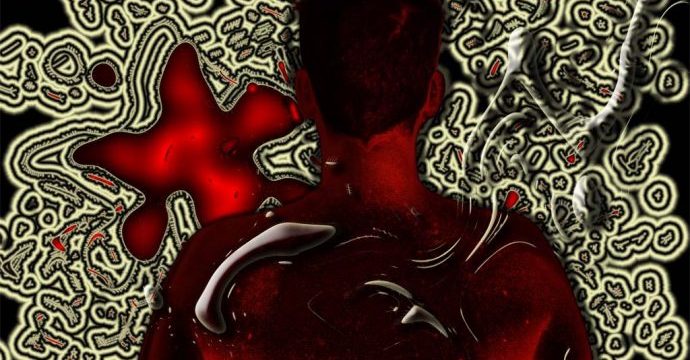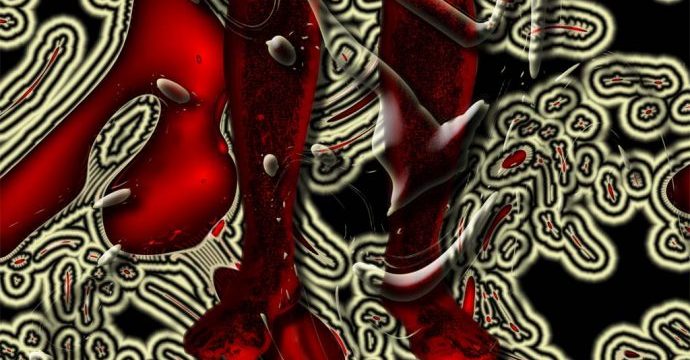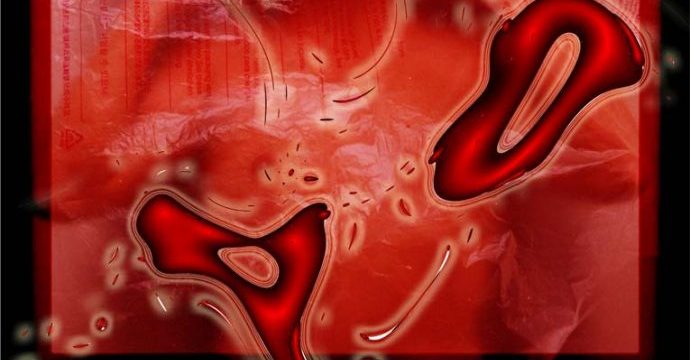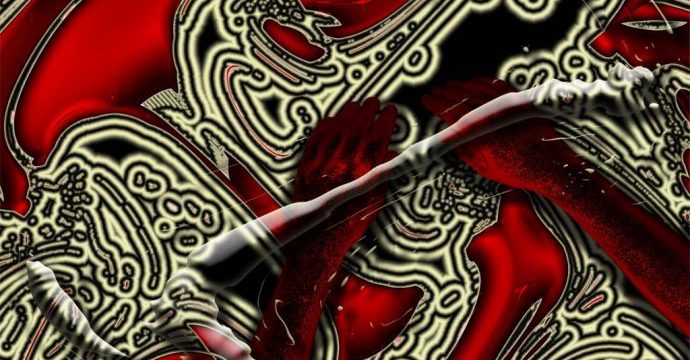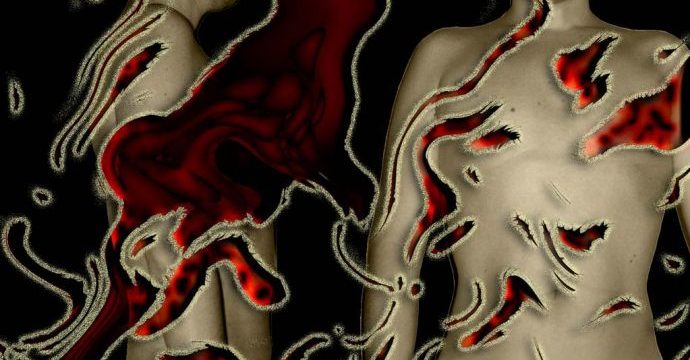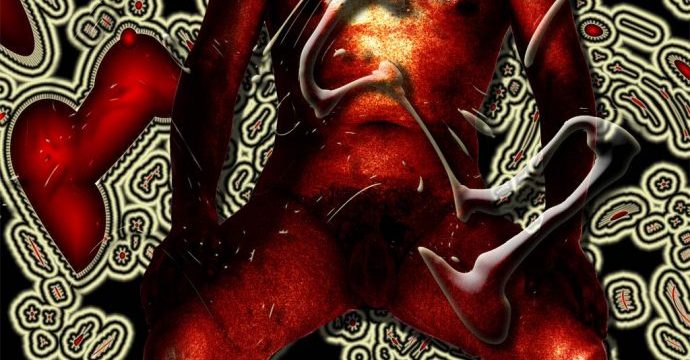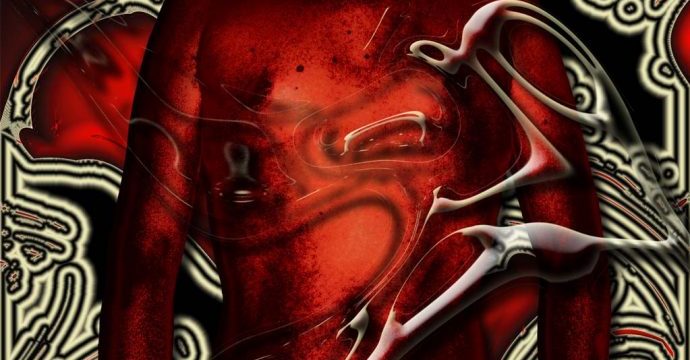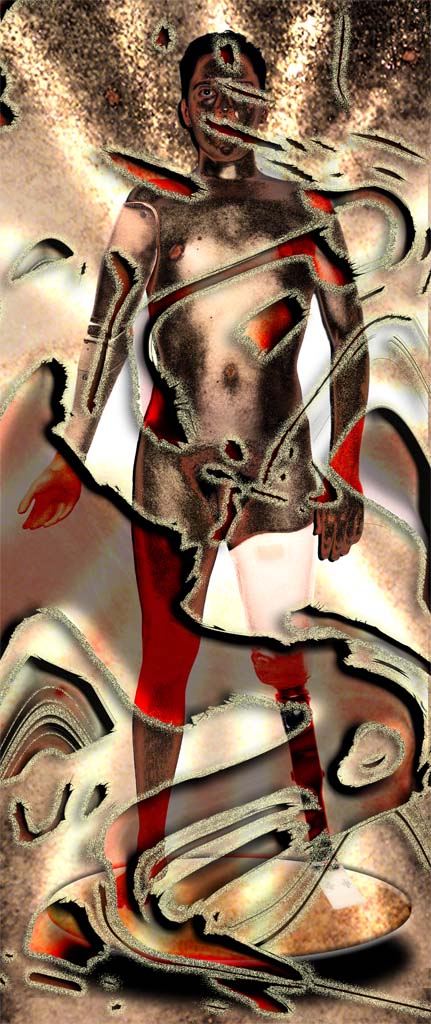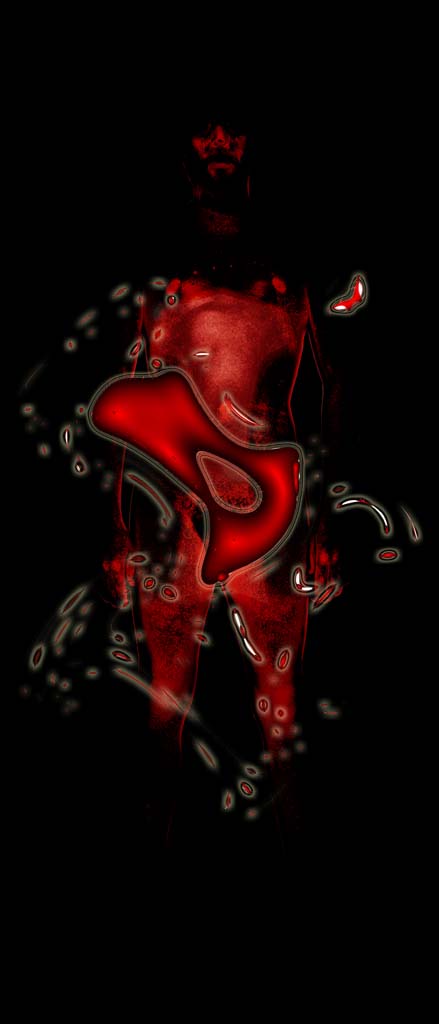VIRUS ME (2001) Updated 2020
- Pier Giorgio De Pinto
- VIRUS ME (2001) Updated 2020
Virus Me
In 2001, exactly 19 years ago, Pier Giorgio De Pinto created a project called Virus Me.
Never as today, we could expect a more topical, direct and shocking message, considering the COVID-19 pandemic that is affecting the entire world population.
As very often happens, the artist draws from his visions anticipations of social phenomena. An innate sensitivity combined with an overall vision that leads the artist to exorcise his fears through the realization of perturbing projects.
A sort of Cassandra that violently puts uncomfortable predictions of the future to a man who is incessantly intent on devouring an everyday life. A forecast that, becoming reality, stops time and creates a new space.
As the sociologist Vincenzo Cesareo defines: art is also a differentiated expression of the ontological structure of reality, […] the product of an extra-rational intuition of central and veiled aspects of reality: this is the prophetic function of art.
Some texts related to the project here*:
VIRUS-ME-PG-DE-PINTO-ENGLISH.pdf
VIRUS-ME-PG-DE-PINTO-ITALIANO.pdf
Les-liaisons-dangereuses_Enrico-Magliano-ENGLISH.pdf
Les-liaisons-dangereuses_Enrico-Magliano-ITALIANO.pdf
*all translations from Italian by Pier Giorgio De Pinto
The project was shown in 2002 in three different places and in three different ways.
1) As an exhibition spread throughout the territory for the third edition of the Festival of art and music Boccheggiàno in strada, Boccheggiàno, Grosseto, Italy. The Festival was promoted by the Regional Project “Porto Franco, Toscana terra dei popoli e delle culture” (Free Port, Tuscany land of peoples and cultures), with the patronage of the Embassy of Venezuela in Italy. Curators were the artists Chiara Bindi and Miguel Rosario.
The series Virus_me was designed as a site-specific installation for Boccheggiàno proliferating as a viral entity and invading with its presence the inside of some private houses and outside some villages in a game of inside_outside, of co-habitation just as it happens in our body due to a virulent attack.
Some digital prints made on fabric were put, for a long time, in direct contact with external walls and atmospheric agents in order to expose them to slow degradation.
http://www.boccheggianoinstrada.it/index.html
2) Within the group exhibition Freeshout!, curated by Federico D’Orazio, at the spaces of Officina Giovani, Cantieri Culturali Ex Macelli, Prato, Italy.
The strong industrial connotation combined with the historical use of these former slaughterhouses has strongly influenced the installation mode of the project. Each work has been perfectly incorporated into this “flesh-eating meat” site using the tools and equipment as a support for the images themselves.
http://www.scanner.it/gusto/freeshout1583.php
Pictures of slaughterhouses and slaughtered meat have always impressed me a lot. They seem to me directly related to the Crucifixion […]. What else are we, if not potential carcasses? When I enter a butcher’s shop, I’m always surprised that I’m not there, hanging there instead of the animal. Francis Bacon.
3) As exhibition in the virtual museum Ezra Kochka Museum, curator Massimo Cantarelli, 2002.
With the advent of the Internet, the term Virus was immediately discussed and therefore it was natural for De Pinto to present the project in another environment, albeit completely digital, of developing a virus such as the Internet networks themselves.
Computer viruses have many similarities with biological viruses in terms of their life cycle, i.e. creation, incubation, infection, activation, propagation, recognition and eradication.
http://web.tiscali.it/ekmuseum/DePinto.htm
Below is the text that accompanied the project and some quotations that De Pinto collected at the time of the creation of Virus Me.
The “Virus Me” project
Around to a body deliberately static , an invisible world wanders, penetrates, storms and gravitates. It appropriates, it devours and it possesses our body. Devoured bodies, tasted, digested, phagocytized. Every day, by the second, we cohabit our body with virus, bacterias, microorganisms, colonies of long spermatic filaments and small fetal limbs, molds and fungus in an apparent and pacific symbiosis and in a slow-acting but constant suicide. When however an external or internal event it storms, it invades in a destructive way and it zaps this equilibrium, we realize we are not alone and something of apparently invisible it prevails ourselves. The chemical and bacteriological warfares of the last international events (ebola; anthrax…) remember us actually how much fragile is this equilibrium and how much vulnerable is our body. The fear to be contaminated, infected to a level more intimate and private it is more and more strong. Bulwarks apparently inaccessible, seal closures as safety orgasms and biological feeding are quite useless if the agent that attaches us it’s so insidious and invisible and the poisons that are administered to us are so well hidden. A due reflection to the observation of human bodies more and more technological, tecno-bodies but just made of flesh. Until it will be flesh and muscles and bones and blood it will be culture of the invisible one. It’s a metaphor of all the sustenances that are propinated to us without our knowledge through the forced and monopolized feeding, through the sick air and falsely spicy of the crowded iper-hypermarkets of the horror. Faked the taste, faked the smell: destructive, in the long run, the effect. And so I find myself with a tecno-body more and more multipurpose but increasingly vulnerable in that old animal side so dear that makes us decaying (fortunately).
Pier Giorgio De Pinto, 2001.
Some suggestions collected at the time of the making of the project (2001).
Marco Binotto from Pestilenze, Castelvecchi Editore.
“The lesions move in the infinitely small. In the unobservable. Only damage, the symptoms, can be seen. Diseases become inexplicable to common sense. All viral, possibly genetic. Without trauma only collapses…”
“Nothing hides anything. We’re transparent. There are no more secrets. Everything is shown, put on display. Even pathologies have no background. The part of the show reserved for the preparation, the machinery, disappears. Even the germ is photographed and disturbed in its privacy, like a VIP. Inspected during his work he takes revenge by creating a disease without secrets, without distinction. As he becomes invisible at the controls, quick in disguise…”
“The virus quickly becomes a sign. He quickly transforms himself into a virus and, as only he is capable, transforms the sign itself into a virus. Incorporeal and flexible, its model represents our sign, ex-instrument of communication, information and meaning, deterritorialized and deprived of weight. Viral Metonymy”. “The virus is the representative of this senseless, meaningless sign, of this pure, broad-band propagation which, disinterested in its contents, looks after only itself, taking all directions”.
Lévy from Collective Intelligence. Mankind’s Emerging World in Cyberspace
“The viral semiotics of propagation, of wild circulation and pure diffusion”..
William S. Burroughs, from On creative Writing.
“ … the single identifying feature of virus: it is an organism with no internal function other than to replicate itself.”
Gianni Canova, op. cit. p.26
“For this is the paradox they carry: […] condemned by their borders to merge with what lies outside them”.
Jean Baudrillard from The Transparency of Evil: Essays on Extreme Phenomena.
To challenge and to cope with this paradoxical state of things, we need a paradoxical way of thinking; since the world drifts into delirium, we must adopt a delirious point of view.”
From G. Deleuze, Francis Bacon. The logic of sensation, University of Minnesota Press, 2004.
“Francis Bacon is this same pietas. In the reading that Gilles Deleuze makes of it, intense to the point of vertigo, the flesh that the painter paints in his martyred bodies is no longer human flesh (from the french term chair), it is the viande, the edible meat, which the Italian translator wisely translated as carne macellata (butchered meat).
The artist himself makes explicit mention of it, with a disarming and terrible lucidity: “The images of slaughterhouses and slaughtered meat have always impressed me greatly. They seem to me directly related to the Crucifixion […]. What else are we, if not potential carcasses? When I enter a butcher’s shop, I’m always surprised that it’s not me, hanging there, instead of the animal.”
There is a basic identity between man and beast which, according to Deleuze, goes beyond any sentimental identification, which links the two natures together beyond any act of will, beyond any humanistic instance: “the man who suffers is beast, the beast who suffers is man”.
From Beauty and the beasts. Meditations on “becoming an animal” by Giorgio Verzotti. Taken from the Skira Catalogue of the exhibition at the MART Museum in Rovereto, Italy Il Bello e le bestie. – Metamorfosi, artifici e ibridi dal mito all’immaginario scientifico (Beauty and the Beasts. Metamorphosis, artifices and hybrids from myth to scientific imagination.) 2004.
The ‘fact’ of Bacon, this viande, this living and painful matter in which he portrays us, perched on perches, lying on platforms or locked in square cages, is the perturbing of our age, which reveals the ‘non-family’ in the very body of the civilized being, suddenly made an object of horror and compassion, and by extension in the world that hosts him.
“Les liaisons dangereuses” between animal and man: a virus tells. Text by the microbiologist Enrico Magliano.
Taken from the Catalogue of the exhibition Il Bello e le bestie. – Metamorfosi, artifici e ibridi dal mito all’immaginario scientifico (Beauty and the Beasts. Metamorphosis, artifices and hybrids from myth to scientific imagination), 2004, published by Skira. Exhibition at the MART Museum of Modern and Contemporary Art of Trento and Rovereto – 11 December 2004 – 8 May 2005.
I have decided to call myself Virgilio (Dante’s Virgil) to accompany you on this journey between the human and animal worlds; it is an ambitious choice, but we viruses recognize that we are presumptuous, aware that we were one of the first living forms on earth when, about four billion years ago, in the drops of primordial broth that bounced, there was a lucky combination of molecules that gave rise to a simple entity with the potential to self-replicate: the first virus.
Men, who had sensed our presence since the end of the 19th century, would not see us until 1939 thanks to the first electron microscope. For me to understand our becoming between the human world and that animal, I will briefly present you an “identity card” of the virus.
We consist essentially of a nucleic acid (DNA or RNA), which contains the genetic information for replication, and a protective protein shell. Peter Medewar, Nobel Prize winner for medicine in 1960, said of us: “Viruses are bad news wrapped in a protein shell”.
To survive, we viruses, who cannot have an autonomous life, must become parasites of other living cells, bacterial, vegetable or animal they are. We are parasites, yes, but as the virologist Dorothy Crawford says, “ingenious, manipulative and dangerous”.
Penetrated into the living cell, our nucleic acid replicates itself and enunciates a ‘genetic diktat‘ that forces cell factories to synthesize proteins to coat the thousands of new viruses that form within the cell itself within twenty-four to forty-eight hours.
We ‘intelligent viruses’ realize that our survival is linked to that of the host that has become parasitized and that if we kill our host, there is little chance for it being transmitted to another and it will succumb itself (think of the cold: if it were fatal, it would no longer exist). As a consequence, in addition to the acute infection, we cause chronic and latent infections, in agreement with the immunitary system; in other words, we live, if possible, on income without running out of capital.
Our ‘poorly cautious’ colleagues, such as the Ebola virus, cause a highly lethal haemorrhagic fever in humans (75% of those infected die within ten days), with the result that the epidemic is rapidly self-limiting due to a lack of hosts.
It has always been accepted that viruses, with rare exceptions, have exclusive targets in a given species. The mouse hepatitis virus can only infect the mouse, the mouse hepatitis virus can only infect humans. Today, on the other hand, numerous cases of transmission of a virus “from another animal to man” have been proven. A veritable “species jump”, which supports the so-called viral anthropozoonoses in which natural barriers are overcome.
Some of us manage to jump from animal to man without any structural modification, others with an adaptation due to mutations, others with a recombination of two different viruses that, by mixing the genes, give rise to a new one.
Charles Darwin said that under adverse conditions, not the strongest survives, but those who can adapt better. From this point of view, we viruses are true masters.
A fascinating example of this ‘genetic shift’ is the one that occurs with avian influenza viruses where the recombination between a human virus and an avian virus (duck, chicken) takes place in the pig, an animal equipped with receptors to host both and which acts as a mixing vessel, that is, a pot of recombination of new viruses capable of attacking and transmitting easily from man to man: a real ‘humanisation’ of the disease.
With this mechanism we invaded the world with the flu pandemics of 1957 (Asia) and 1968 (Hong Kong). In another case (Hong Kong in 1997), the virus responsible for the epidemic was the product of the recombination of three strains of avian influenza viruses that infected quails, geese and ducks respectively. The recombination of these three viruses resulted in intermediate variants that infected different hosts, the last of which, presumably a chicken, infected humans permanently.
It is surprising to remember how a swine virus was responsible for the deadly influenza pandemic of 1918 known as the Spanish flu, which caused the deaths of over twenty million people in one year. Evidence of this is that in 1997 American researchers were able to isolate this same virus from the lungs of a woman who died in Alaska in 1919; the virus buried in permafrost (permanently frozen sands) was in excellent condition as if it had been in a freezer for eighty years.
Even for one of our most feared representatives, HIV (Human Immunodeficiency Virus, the one responsible for AIDS) has been hypothesized to be derived from animals.
A virus similar to HIV, the so-called Simian Immunodeficiency Virus (SIV), has been isolated from chimpanzees. One hypothesis is that years ago in Central Africa a hunter injured himself during the dismemberment of a chimpanzee for food purposes by contaminating himself with the animal’s blood.
The chimpanzee was probably infected with the immunodeficiency virus of the monkey, which, after a transformation, evolved as HIV in the new host (cut-hunter hypothesis).
The SARS virus (Severe Acute Respiratory Syndrome) is another example of how the Pandora vase of our animal reserve still has so much to distribute.
The responsible for SARS, known as the Coronavirus because of the ‘crown’ shape of the wrap, does not resemble any of the other Coronaviruses in the same family, which are the agents of the common cold.
It is therefore neither a mutation nor a recombination of a known virus. It probably evolved separately from an ancestor coronavirus that infected animals, such as poultry, in rural areas of southern China for a long time before the species jumped over two years ago.
The ‘reservoir’ animal is still unknown today, although recently the virus has been isolated from a carnivore, a civet, from a badger and a raccoon and has been transmitted under experimental conditions to the ferret and the mouse.
SARS was promptly identified and blocked in its spread. Of course, if the Chinese farmer who first contracted SARS from chickens had also contracted human flu at the same time, then the SARS virus could have ‘learnt’ from the human flu virus, a great expert in human contagion, how to go from one man to another, triggering a deadly pandemic that is difficult to control.
Several factors favour the jump of virus species, in particular, human interventions that upset the natural habitat of animals (disbandment, elimination of fundamental species in the control of the balance of the chain of life), and irrational zootechnics that, by keeping different animal species amassed, favours dangerous “genetic rearrangements”.
In addition to this, there are also sudden climatic changes that upset the planet’s ecosystems and consequently the biological cycles of animals involved in the chain of infection: malaria, for example, has recently appeared in Russia following a rise in temperature, which has allowed mosquitoes, essential vectors of infection, to survive in those regions.
An interesting biological conundrum involving humans and animals is the one linked to a group of transmissible diseases that cause serious degenerative brain damage (including the infamous Bovine Spongiform Encephalopathy – BSE, or Mad Cow disease that has appeared in the UK since the early 1990s1).
This disease is supported by a causal agent that has long been considered one of us (a defective virus called Virino) and now identified as a new entity: the so-called Prion.
Stanley Prusiner, who in 1977 won the Nobel Prize for his studies in this field, called it “one of the strangest creatures on this planet”.
The American scientist enunciated a revolutionary and almost ‘heretical’ hypothesis, which predicted the existence of a new class of transmissible agents without nucleic acids and of an exclusively protein nature (Prion derives from: proteinaceous infectious particles). During the infection, the Prions reach the brain directly and induce a modification of a protein normally distributed in brain tissue that is very similar to the Prion itself. This change gives rise to a chain reaction in which the new modified molecules bypass the control systems that regulate the metabolism of proteins and settle in the black tissue, transforming its structure into a sort of sponge, hence the name Spongiform Encephalopathy.
In man, the beginning of the history of spongiform encephalopathies can be traced back to Kuru, a disease that has been widespread for over a century in a tribe of cannibals (Fore) in Eastern New Guinea, studied by the American pediatrician Carleton Gajdusek, who won the Nobel Prize for these diseases.
This paralyzing neurological disease (kuru means ‘trembling’) was widespread only among women and children, who were entrusted with the preparation of the corpses and given the brain (infected) as food, while men were responsible for other meats. With the prohibition of cannibalism, towards the end of the 1950s, the disease disappeared.
Another Prion infection in humans, similar to BSE, is the very rare Creutzfeld-Jacob disease (one case in a million inhabitants) described in 1920 and inexplicably produced by spontaneous genetic mutations2.
A ‘species jump’ that is not natural but forced is also what xenotransplantation, i.e. the transplantation of organs from animals to humans, forces us to do.
The possibility of using animal organs for transplantation in humans has always fascinated researchers. The first xenotransplantation dates back to 1963 when Keith Reemtsma succeeded in transplanting a chimpanzee kidney to a woman who survived nine months. After some other negative experiences due to rejection, in the early nineties, the team of the University of Pittsburg, led by Thomas Stazzi, performed the first two transplants of baboon liver to the man, but the recipients did not survive beyond two months.
These interventions, in particular with the use of primates, chosen for the similarity of their genetic heritage to that of man (over 90%), provoked controversy and violent protests from animal rights activists, even though xenotransplantation has recently been defined by the Vatican as ‘acceptable’. At present, the attention of the experimenters is focused on the pig for reasons of anatomical compatibility of the organs and their easy availability.
In order to transplant organs that circumvent the immunological rejection of the recipient, geneticists have managed to modify the genetic code of the animal in the laboratory, making it more similar to the human genome; to this end, the so-called ‘transgenic’ pigs have been created, but a significant example of a new way of ‘becoming’ between a human being and an animal!
However, the opposite can also happen, at least in the realm of literature, as the Russian doctor and writer Michail Bulgakov taught us, who, in The heart of a Dog, back in 1925, imagined a shocking transplantation of the pituitary gland from man to animal!
The most likely serious problem in xeno-transplantation, however, is the infectious problem, that is, the risk that with the transplanted organ some of us viruses, silent parasites of the animal, are transferred to humans: a ‘jump’, which is facilitated by the massive anti-rejection therapy to which xeno-transplanted patients are subjected who, paralyzed in the immune system, are not able to counteract the pathogenic action of us viruses. We believe in the etymology of our name: virus as if to say poison.
In the very near future, however, even our role as ‘villains’ could be modified by genetists who, knowing us as elementary units used to sneak into cells, could exploit our experience by using us as a vehicle of ‘good genes’ to replace anomalous or missing genes. That’s not all: another use of viruses useful to humans could, for example, be to become ‘bullets’ that are shot electively at cancer cells until they are destroyed.
This short journey on the subject of human being-animal-virus relationship is over; it’s time to get out… “to see again the stars.” If we imagine that the stars are the lights that light the way to research, then we viruses remember the star Augusto Giovanardi… He beat the hell out of us with his polio vaccination.
Note 1: The most probable hypothesis is that the cause of the outbreak of the epidemic in cattle is to be attributed to the use of meat and bone meal obtained from the slaughter scraps of sheep affected by a disease that has been present for centuries in British flocks and called “Scrapie”.
Scrapie is a spongiform encephalopathy of the sheeps that induces aggression and sensitivity reaction with a characteristic and violent itching that leads to the animals scratching violently until they have obvious fleece losses (to scrape means ‘flaying’).
Note 2: In 1996, there were reports of spongiform encephalopathy in humans supported by a different strain from the one isolated in the above mentioned Creutzfeld-Jacob disease. This strain was found to be identical to that of bovine disease, confirming the hypothesis of transmission of the Prion from animal to man by feed. Measures to control cattle feed and the exclusion of suspect beef from trade have broken the chain of infection.
The anguish over this disease has also been interpreted in artistic terms by painters and poets; it is worth mentioning the Carol Rama cycle Mucca Pazza (Mad Cow) on mad cow disease in the second half of the nineties and the acrostics of Sanguineti in 1997.


